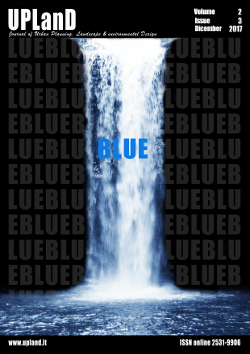Hydroelectric power: architecture, water and landscape
Main Article Content
Abstract
This contribution wants to sum up some of the considerations developed during the research carried out for BIM of Adige - Trento Province Consortium of Municipalities - and ended on April 2016 with the conference “La città dell’Alt(r)o Adige. Esiti di un percorso di ricerca per il BIM Adige”.
Research outcomes show a result – not a definite one - of a survey done with an across-the-board point of view of the disciplines that deal with the relationship between watercourses and human settlements. This viewpoint goes through the disciplines’ borders making the architecture and landscape project again a central focus among the most pivotal issues. This reflection begins with a phenomenon that has emerged with some urgency in recent years: the exponential growth of the demands for the creation of new lines and hydroelectric plants, especially small or very small. This new phase coincides with one of the most co) mplex moments of watercourse management due to the overlapping of distinct goals set by two different European Directives that are in conflict with each other: the need to increase the use of renewable energies (Directive 2009/28 / EC) and the need to meet the requirements for classification, protection and improvement of water bodies (Directive 2000/ 60 / EC). This theme becomes an opportunity to make wider reflection on the conflicts generated by the different uses of watercourses and the need to rethink them according to an ecosystem approach.
For a wider discussion of the following subjects, please see the volume titled La città dell’altro Adige, of the same author, published by ListLab 2016.
Downloads
Article Details

This work is licensed under a Creative Commons Attribution-NonCommercial-NoDerivatives 4.0 International License.
Authors who publish with this journal agree to the following terms:- Authors retain copyright and grant the journal right of first publication with the work simultaneously licensed under a Creative Commons Attribution License that allows others to share the work with an acknowledgement of the work's authorship and initial publication in this journal.
- Authors are able to enter into separate, additional contractual arrangements for the non-exclusive distribution of the journal's published version of the work (e.g., post it to an institutional repository or publish it in a book), with an acknowledgement of its initial publication in this journal.
- Authors are permitted and encouraged to post their work online (e.g., in institutional repositories or on their website) prior to and during the submission process, as it can lead to productive exchanges, as well as earlier and greater citation of published work (See The Effect of Open Access).
References
Bryson, N. (1983). Vision and painting. The logic of the gaze. London, UK: MacMillan.
CIRF (2014), Report: L’energia “verde” che fa male ai fiumi. Qualità dei corsi d’acqua e produzione idroelettrica in Italia: un conflitto irrisolto.
Da Empoli, G. (2013). Contro gli specialisti. La rivincita dell’umanesimo. Venezia, IT: Marsilio editori.
Jenks, C. (ed.) (1995). Visual culture. London, UK: Routledge.
Jørgensen, S.E., Nielsen, S.N., & Mejer, H. (1995). Emergy, environ, exergy and ecological modelling. Ecol. Mod., 77, 99-109. doi: 10.1016/0304-3800(93)E0080-M
MAE (2005): http://www.millenniumassessment.org/documents/document.449.aspx.pdf. Accessed on 03.07.2017.
Ministero Ambiente (2017): http://www.minambiente.it/pagina/aspetti-economici-e-impatto-ambientale. Accessed on 03.07.2017
Moccia, F.D., & Sgobbo, A. (2013). Flood hazard: planning approach to risk mitigation. WIT Transactions on the Built Environment, 134, 89-99. doi:10.2495/SAFE130091
Moccia, F.D., & Sgobbo, A. (2016). Flood hazard: planning approach to risk mitigation and periphery rehabilitation. In S. Syngellakis (ed.), Management of Natural Disasters (pp. 129-144). Southampton, UK: WIT Press. doi: 10.2495/978-1-84566-229-5/012
Mori, G. (ed.) (1992). Storia dell’industria elettrica in Italia. Le origini 1882-1914. Roma-Bari, IT: Laterza.
Rost, P. (1929). Il carbone bianco, fattore di potenza. L’economia nazionale, luglio 1929.
Siligardi, M. (2016), Ecosistema fluviale e idroelettrico. In C. Rizzi (ed.), La citta dell’altro Adige. Trento-Barcellona: ListLab.
WWF (2014): European Alpine Program, Report: Save the Alpine rivers!
Zolezzi, G., & Carolli, M. (2016), Riaqualificazione fluviale e idroelettrico. Dall’ingegneria Idraulica all’eco-idraulica. In C. Rizzi (ed.), La citta dell’altro Adige. Trento-Barcellona: ListLab.

